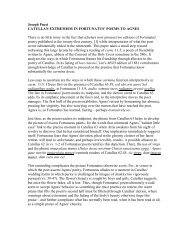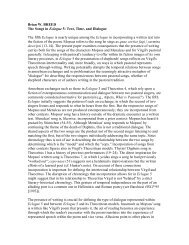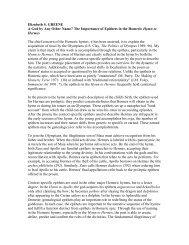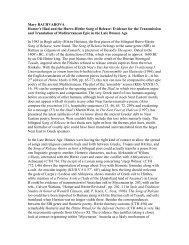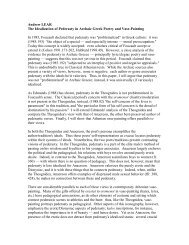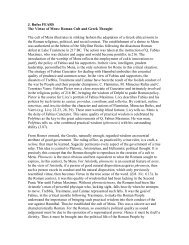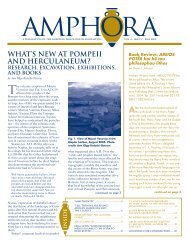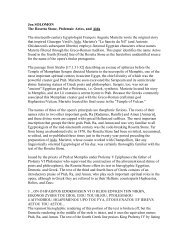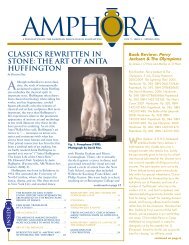John H. STARKS, Jr. [vo]cales vultus:Pantomime Actresses in Latin ...
John H. STARKS, Jr. [vo]cales vultus:Pantomime Actresses in Latin ...
John H. STARKS, Jr. [vo]cales vultus:Pantomime Actresses in Latin ...
Create successful ePaper yourself
Turn your PDF publications into a flip-book with our unique Google optimized e-Paper software.
<strong>John</strong> H. <strong>STARKS</strong>, <strong>Jr</strong>. [<strong>vo</strong>]<strong>cales</strong> <strong>vultus</strong>:<strong>Pantomime</strong> <strong>Actresses</strong> <strong>in</strong> Lat<strong>in</strong> Imperial Inscriptions<br />
jstarks@agnesscott.edu<br />
The dramatic genre that Romans called ‘pantomime’ typically featured male pr<strong>in</strong>cipal actors who<br />
danced multiple solo roles and captivated audiences with their silent, expressive gesticulation<br />
(cheironomia) and their seamless transitions between male and female characters. Lucian’s de Saltatione,<br />
Libanius’ Oration 64, and numerous <strong>in</strong>scriptions honor<strong>in</strong>g pantomime dancers as victorious stars leave<br />
the impression that the lead dancers were always men, and that women served only as ‘backup s<strong>in</strong>gers’<br />
for those dancers. Although female pantomime dancers appear <strong>in</strong> Byzant<strong>in</strong>e literary sources, evidence for<br />
pantomime actresses <strong>in</strong> the imperial Roman West has often been overlooked or <strong>in</strong>sufficiently analyzed.<br />
Seneca sarcastically mentions pantomimae with enormous dowries (Helv. 12.6); elsewhere he scolds<br />
noble husbands and wives show<strong>in</strong>g off their newest pantomime skills on private stages (Nat. 7.32.3). The<br />
octogenarian noblewoman Aelia Catella danced to the accompaniment of an <strong>in</strong>firmed chorus (Cass.Dio<br />
61.19.2), a production Nero probably staged as a spectacular twist on the youthful energy of pantomime.<br />
A late-first century epitaph from Gaul reads Hellas pantomim(a) hic quiescit, ann(is) xiiii. Sotericus<br />
fil(iae), (ILS 5210a). Some scholars assume that Hellas was a boy (Lepp<strong>in</strong> Histrionen) or omit reference<br />
to her gender (Csapo/Slater Context of Ancient Drama). But Hellas is a Greek fem<strong>in</strong><strong>in</strong>e, and thus always a<br />
woman’s name (Sol<strong>in</strong>,CIL 6,12). At her young age she may have been a member of a corps de ballet or<br />
ensemble, such as the pantomimic cast of the ‘Judgment of Paris’ at Apul. Met. 10.30ff. But consider<strong>in</strong>g<br />
that we know of other young saltatrices (9, CIL 6.10143; 14, CIL 8.12925), a ten-year-old mima (IGUR<br />
275), and a twelve-year-old boy who “danced and pleased crowds (CIL12.188),” Hellas’ specific<br />
designation as a pantomima may <strong>in</strong>dicate that she danced leads.<br />
The pantomime Actius Anicetus (CIL10.1946) and his troupe are greeted <strong>in</strong> Pompeii by fans (fanatici<br />
Actiani Anicetiani, CIL4.2155) several times (Frankl<strong>in</strong> AJPh 1987). An Actius Castrensis is saluted as<br />
Anicetianus (4.2413d) alongside what I believe is a truncated fem<strong>in</strong><strong>in</strong>e form of the same term<br />
(Aniceti)ania; a Chloe Acti Castre(n)sis appears at CIL 4.1646. Chloe or some other female pantomime<br />
may be the (Aniceti)ania alluded to. Castrensis was probably a pantomime of Actius Anicetus, and he<br />
may have managed/owned or worked with a pantomime actress whom the greeter knew, though not by<br />
name. More reveal<strong>in</strong>g is a histrionica Actica noted on a bathroom wall (4.5233) and an Actica at the large<br />
theater (4.2463b). S<strong>in</strong>ce these were written about the time histrio was becom<strong>in</strong>g a popular title for<br />
pantomime actors (Petr. 52.9), I take histrionica as a hapax legomenon <strong>in</strong>dicat<strong>in</strong>g that Actica was a<br />
pantomime actress of Actius Anicetus and/or Castrensis. The multiple, colloquial attestations of actresses,<br />
the salutation to performers whose names may have been unknown, and the possible partnership with a<br />
male performer all add to our understand<strong>in</strong>g of pantomime troupes.
Sophe Theorobathylliana arbitrix imboliarum (CIL 6.10128) is recognized on a bone tablet.<br />
Theorobathylliana is apparently a composite of the pantomimes Theoros (CIL 6.10115; Theoriani 4.1891)<br />
and Bathyllus (Ath. 1.20.d-e). Sophe was a head mistress, manager/ choreographer and/or pr<strong>in</strong>cipal<br />
performer among emboliariae, performers of entr’actes (<strong>in</strong> her case, likely pantomimic). The fabric of<br />
this portable artifact, its irregular spell<strong>in</strong>g for (e)mboliar(iar)um, and the unusual, epithet suggest that it<br />
may be a personal advertisement or résumé of Sophe’s professional skills. She may have worked for<br />
Theoros and Bathyllus <strong>in</strong>dividually or as partners, or she may have specialized <strong>in</strong> their pantomimic style<br />
(Bathyllus <strong>in</strong>vented a comic style of pantomime) or styles (if Theoros danced tragic pantomime, Sophe<br />
might be advertis<strong>in</strong>g her versatility).<br />
Manganaro SicGym 1970.77-79 reconstructs a Roman epitaph to a pantomime actress of the<br />
second to third century CE who, like the pantomime V<strong>in</strong>centius (AE 1956.122; Csapo/Slater 5.36),<br />
proclaims her exceptional virtue to refute stereotypes about performers’ disreputable lifestyles. Her<br />
onstage performance “<strong>in</strong> mischie<strong>vo</strong>us playact<strong>in</strong>g (lasci<strong>vo</strong> lusu)” pleases the gods just as much as her<br />
morality and de<strong>vo</strong>tion to family. Manganaro then restores the key l<strong>in</strong>es, [sae<strong>vo</strong>s Ae]acidas saltavi,<br />
carmen amavi, /[ob nover]<strong>cales</strong> <strong>vultus</strong> fui cognita digne, “I danced the savage ‘Sons of Aeacus,’ I loved<br />
the song, I was deservedly well known for portrayal of stepmothers.” Manganaro’s reconstruction oddly<br />
<strong>in</strong>vites readers to proclaim the story of a woman who played <strong>in</strong>sidious stepmothers onstage. This clashes<br />
harshly with her virtues mentioned earlier, so, after exam<strong>in</strong>ation of the stone <strong>in</strong> Rome, I reconstruct [et<br />
divas pl]acidas saltavi, “I even danced the roles of k<strong>in</strong>dly goddesses,” and [propter <strong>vo</strong>]<strong>cales</strong> <strong>vultus</strong> fui<br />
cognita digne, “I was duly known for my facial expressions that spoke.” Both these sentiments appear <strong>in</strong><br />
Aristaenetus’ late-Greek letter to Panarete (1.26), where he attests the pantomime actress’ representation<br />
of Aphrodite and Polyhymnia, and lauds her ability to “show all sorts of words,” as a silent “orator”<br />
whose body language presents a “versatile silence.” Both women’s positive presentations of goddesses<br />
and their silent, but expressive, faces speak <strong>vo</strong>lumes.


![John H. STARKS, Jr. [vo]cales vultus:Pantomime Actresses in Latin ...](https://img.yumpu.com/11930335/1/500x640/john-h-starks-jr-vocales-vultuspantomime-actresses-in-latin-.jpg)
